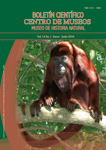Authors
Abstract
The use of the habitat by the neotropical river otter was studied using indirect evidence in the lower Roble river. From August 2006 until March 2007, walks were taken along a 5 kilometer stretch of river, and 5 m of the river bank were examined on each side, with repetition every 15 days, in search for signs of the neotropical river otter. The terrestrial and aquatic habitat was characterized every 400 m and a vegetation coverage map was elaborated. The landascape matrix is dominated by pasture used for cattle grazing, followed by secondary and mixed forests and Guadua angustifoli forests, which are the dominant species, presenting abundant shrubbery and fallen logs that provide camouflage and refuge for the otter. The otter prefers territory marking sites in the summer (dry) season (January- March), rocks emerging from the stream, and the determining characteristics for choosing such rocks was size, height, bank proximity, and vegetation coverage (r2 = 20.44; cp = 2.151, n = 10). Whereas during the winter (wet) season (October - December), smaller rocks, yet high enough to avoid the stream during a rise in the water level, were chosen by the otter (r2 = 24.64; cp = 0.196, n = 10). 36.8% of the total marked rocks were reused during the study period. The preference of the neotropical river otter for this type of habitat with well preserved riverside vegetation is remarked, concluding that the low basin of the Roble river is a important area for the conservation of the species.
References
ALARCON, G.G. & SIMÕES-LOPES, P.C., 2004. The Neotropical Otter Lontra longicaudis Feeding Habits In A Marine Coastal Area, Southern Brazil. IUCN Otter Spec. Group Bull., 21 (1): 24-30.
ALBERICO, M.; CADENA, A. & HERNÁNDEZ-CAMACHO, J.I., 2000. Mamíferos (Synapsida: Theria) de Colombia. Biota colombiana, 1 (1): 43-75.
ARCILA, D., 2003. Distribución, uso de microhábitat y dieta de la nutria neotropical Lontra longicaudis (Olfers 1818) en el Cañón del Río Alicante, Antioquia, Colombia: Trabajo de grado para optar al título de Biólogo, Instituto de Biología, Universidad de Antioquia, Medellín, Colombia.
________., 2006. Proyecto plan de manejo y conservación del manatí Thrichechus manatus manatus y la nutria Lontra longicaudis en la cuenca baja del río Sinú. Informe final Septiembre 2006. Fundación Omacha. 234p.
BOTELLO, J., 2004. Evaluación del estado de la nutria de río Lontra longicaudis (Olfers 1818) en el ríoCauca, zona de influencia del municipio de Cali - Departamento del Valle del Cauca. CVC. Fundación Natura, Colombia.
CHANIN, P., 1985. The natural history of Otters. Croom Helm, Australia.
COLARES, E.P. & WALDEMARIN, H.F., 2000. Feeding of the neotropical river otter Lontra longicaudis in thecostal region of rio grande do Sul State, southern Brazil. UICN otter specialist group bull. Wageningen, 17: 6-13.
EMMONS, L.H., 1997. Neotropical Rainforest Mammals. A Field Guide. The University of Chicago Press, Chicago.
FOSTER-TURLEY, P.; MACDONALD, S. & MASON, C., 1990. (eds.) Otters: An action plan for their conservation. IUCN/SSC Otter Specialist Group, Gland, Switzerland. 126p.
FREITAS, S.R.; CERQUEIRA, R. & VIEIRA, M.V., 2002. A device and standard variables to describe microhabitat structure of small mammals based on plant cover. Braz. J. Biol., 62 (4b): 795-800.
GARCÍA, C.M.. & QUINTANA, R.D., 2005. Uso de canales deforestación por el lobito de río (Lontra longicaudis) en el bajo delta del Paraná en relación a sus características fisicoquímicas. Poster presentado en las XX Jornadas Argentinas de Mastozoología en Noviembre de 2005.
GORI, M.; CARPANETO, G.M. & OTTINO, P., 2003. Spatial distribution and diet of the neotropical otter Lontra longicaudis in the Ibera lake (Northern Argentina). Acta theriológica, 48: 495-504.
GUZMÁN-LENIS, A. & CAMARGO-SANABRIA, A., 2004. Importancia de los rastros para la caracterización del uso de hábitat de los mamíferos medianos y grandes en el bosque los mangos (Puerto López, Meta, Colombia). Acta Biológica Colombiana, 9 (1): 11-22.
INSKIPP, T. & GILLETT, H.T.J., 2005. (eds.) Lista de especies CITES y apéndices y reservas anotados de la cites Compilada por el PNUMA Centro de Monitoreo de la Conservación Mundial. 421p.
KASPER, C.B.; FELDENS, M.J.; SALVI, J.A. & ZARNARDI, G.C., 2004. Estudo preliminar sobre a ecologia de Lontra longicaudis (Carnívora, Mustelidae) no Vale do Taquaria, sul do Brasil. Revista Brasilera de Zoología, 21 (1): 61-72.
KRUUK, H., 1995. Wild otters: Predation and populations. Oxoford University press, Great Britain.
LARIVIÈRE, S., 1999. Lontra longicaudis. Mammalian Species, 609: 1-5.
QUADROS, J. & MONTEIRO-FILHO, E.L.A., 2002. Sprainting sites of the neotropical otter, Lontra longicaudis, in atlantic forest area of souther Brazil. Mastozoología Neotropical, 1: 54-66.
SPINOLA, R.M. & VAUGHAN, C., 1995. Abundancia relativa y actividad de marcaje de la nutria neotropical (Lutra longicaudis) en Costa Rica. Vida Silvestre Neotropical, 4 (1): 38-43.
TRUJILLO, F. & ARCILA, D., 2006. Nutria neotropical Lontra longicaudis: 249-254 (en) RODRÍGUEZ-M., J.V.; ALBERICO, M.; TRUJILLO, F. & JORGENSON, J. (eds.) Libro rojo de los mamíferos de Colombia. Serie de libros rojos de Especies Amenazadas de Colombia. Conservación Internacional Colombia, Ministerio de Ambiente, Vivienda y Desarrollo Territorial. Bogotá, Colombia.
WALDEMARIN, H.F., 2004. Ecologia da Lontra neotropical (Lontra longicaudis), no Trecho Inferior Da Bacia Do Rio Mambucaba, Angra Dos Reis: Tesis doctoral Universidade Do Estado Do Rio De Janeiro, Instituto De Biologia Roberto Alcântara Gomes, Programa De Pós-Graduação Em Biología Área De Concentração Em Ecología.
WALDEMARIN, H.F. & ALVARES, R., 2008. Lontra longicaudis. IUCN 2010. Lista Roja de Especies Amenazadas IUCN. Versión 2010.1. www.iucnredlist.org [Consultado el 1 de abril de 2010].

 PDF (Español)
PDF (Español)
 FLIP
FLIP


















